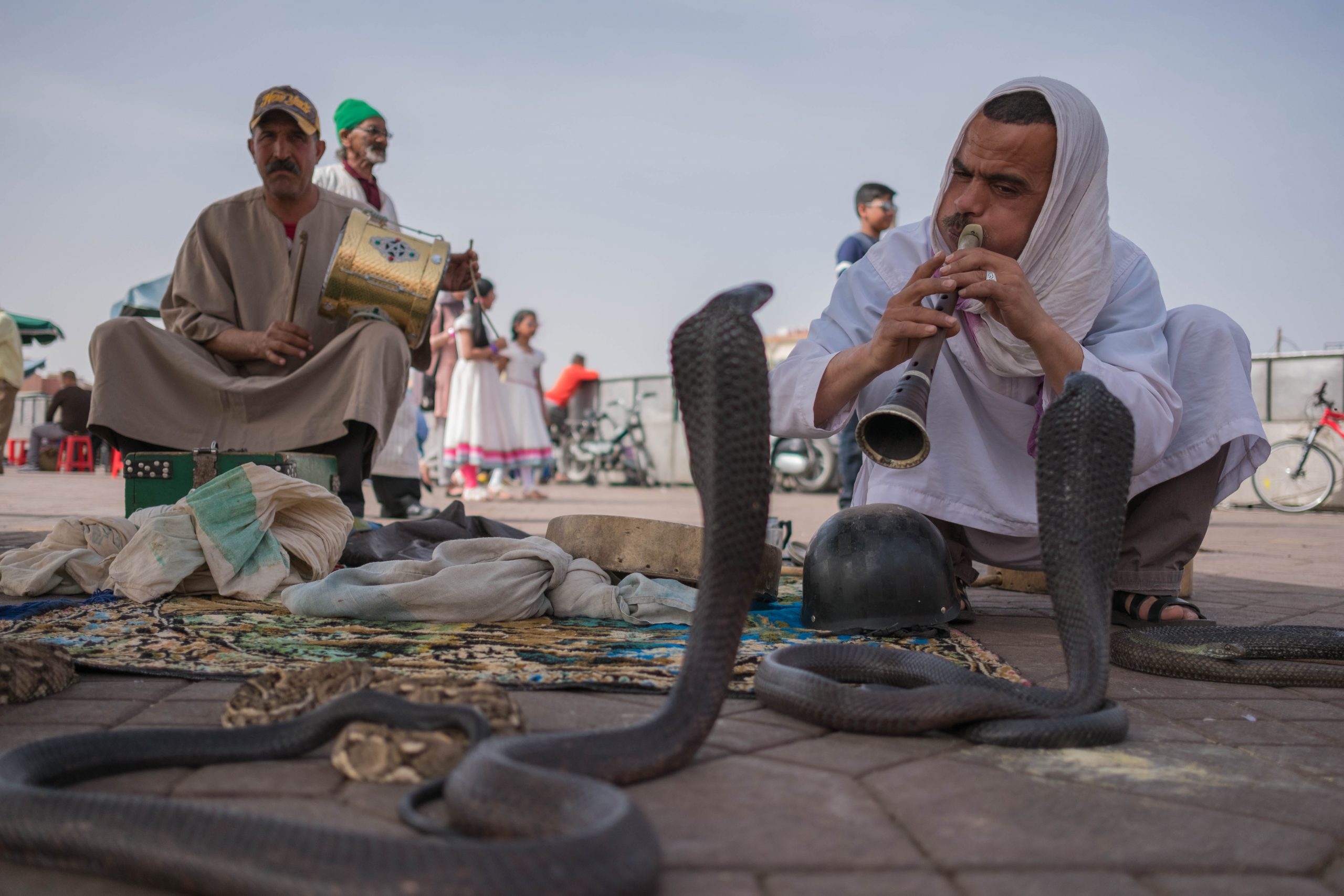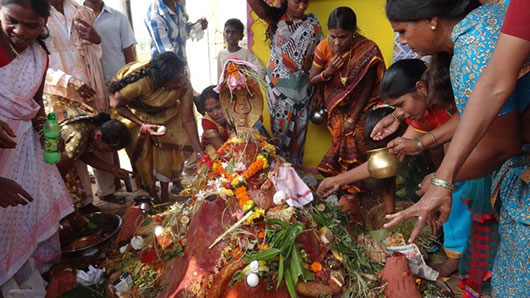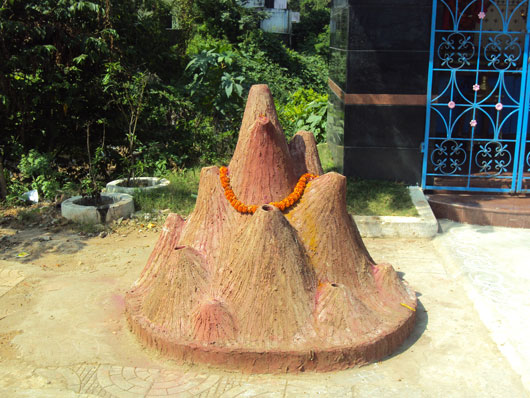
Cobra Rescue
2013 Update:
The festival of Nagla Chauvathi is the time for every Hindu to worship the cobras for prosperity and general auspiciousness and the devotees ignorant of the consequences to the cobras perform the rituals in hope of goodness.
The truth behind the scenario was not known to the people worshipping cobras until VSPCA raised voice against this merciless practice. The cobras were being supplied by the tribal people for entertainment and religious occasions; where after the religious rituals cobras die due to suffocation and pain caused by stitched and gangrene mouths, they die and their skins are also sold after their death. 10-15 days prior to the festival the cobra mouths are stitched and with completely no food and water for many days they fail to survive this agonizing ordeal.
This is our oldest project to alleviate the sufferings of the cobras and we have been very successful in our area. It took us almost 8 years to end the painful story of the cobras. But we cannot afford to be complacent about the safety of cobras and so our team is always out in action to ban the supply of cobras from outside or inside the city. It was very pleasant to see devotees worshipping the snake pits and idols instead of the cobras.
With our awareness and education efforts to the local people, the city witnessed zero cobra supply for religious or entertainment purposes in the last 3 years. This is our oldest campaign in liberating the cobras from cruelties which is now a success story of VSPCA.
We are reaching to the other districts of the States to create awareness and to stop the cruelty going on in the name of religion.

2011 Update:
We are very happy to inform you that this year too there was not a single snake brought in by the middlemen to be used in the Nagacahuvithi festival, a religious festival day praying to the Cobra Snake. Instead, there was a huge crowd praying to makeshift snake pits, idols, temples and even in houses. It is indeed a great relief for our teams who had been out during the night and day yesterday. Below you can read about the history behind this very successful project that finally brought an end to the cruel ordeal done to the hundreds of cobras every year when the cobras would die after almost 10 days of no food and fresh air with their fangs removed and mouth stitched. It took us almost 8 long years to bring an end to such cruelties under very trying circumstances.

2010 Update:
This year there were no incidents of cobras being brought into the city for the Nagulachavithi festival. It was a gradual but definite transformation from previous years of cruel catching, trapping, stitching of the mouth, and water deprivation for 10 to 15 days prior to the festival date. Almost all cobras die after this ordeal. It took us six years, but we’re now in the 3rd year of zero cobras being used during the festival. It required a lot of awareness education and media publicity, coupled with raids with the Forest Department.
Today the devotees pray in a makeshift snake resting place to an artificial image. Long live the Cobra!!!
History
Pradeep Nath writes:
Diwali is a very festive time in India. Two or three weeks afterwards we have the Nagala Chauvathi festival. Devotees worship the cobra during this time for health, wealth and general auspiciousness. All Hindus are required to perform these pujas.
But I always found it curious and very disturbing at the way the cobras were being treated in the name of religion.

A stitched mouth of the Cobra being displayed on the occasion of the “Nagachaviti” festival.
Ignorant devotees, not knowing of the sad consequences to the snake, gather in large numbers and pour milk on them, rub vermilion on their head, light firecrackers in front of them and offer incense sticks to the hapless snakes. At the end of this, the snake just dies of suffocation and exhaustion and the snake charmers remove the skin for further sale. Those snakes that are still alive are killed or throw away ill and injured into the nearby bushes and forests.
This all goes hand in hand with the tribal people living near the edge of the forest whose livelihood depends on supplying snakes for entertainment and religious occasions. Specifically, there is a tribe nicknamed “Snake People” who reside 40 km. from Visakhapatnam.
But these are all illegal activities violating the Prevention of Cruelty to Animals Act and the Indian Wildlife Act wherein the cobras are placed on Schedule I of the Act which gives should very high protection to them!
Once I became aware that these actions could be stopped I took action in two ways: religious education and legal means. Since 1996 when our animal shelter officially began I studied the situation and tried to understand all the surrounding circumstances and customs.
In the next few years, I started approaching The Forest Department educating them about these events and their illegalities. They had to oblige with field staff and a vehicle. In those early days, our animal shelter had no vehicle of our own.
We worked hard to convince the media and the public. We were almost beaten up during these years by the ignorant devotees who didn’t realize we had the best interest of animal welfare and the law at heart. However, due to the help of the supportive media, we were able to prove the sad endings of the very snakes they were worshipping. Our awareness campaign through press releases finally worked in creating public awareness!
The dramatic turnaround happened in 2002 when not a single tragic incident of snake abuse occurred in the city and has continued until this day. It is wonderfully astonishing to observe the definite change among the devotees who were so hostile just two years ago. It took us nearly four years to convince them that the cobras were actually dying after their prayers.
Now the same people were seen bringing in toy snakes, setting up of snake-like images with clay and sand (picture above) and digging of artificial holes. In the “snake pits”, the holes they have dug, they put in huge chicken eggs offered by the devotees and pour milk over everything. Afterwards, the snake charmers collect the eggs and sell them as holy offerings. It is good revenue for them and they cannot say that they have lost their income because they are not using snakes anymore. We felt that they were also happy that their income from this festival was now easier than before when they had to hunt for the snakes–keeping them confined in baskets for days–removing their fangs, stitching their mouths even though there is no question of feeding them in that cruel way.
Our new Conservator of Forest, Mr.Padmanabham was also happy at the outcome although we did the vigil all alone this year without any of the enforcing authorities. The entire city wore a festive look in what we felt was an auspicious and humane direction.
Visakhapatnam is now devoid of these merciless practices but now we have to expand to the rural and surrounding areas. What is still happening is that the snake-charmers catch the cobras nearly ten days before the festival; remove the fangs with primitive methods and then stitch up their mouths and leave them in small baskets without any food.
On the occasion, during these three hours of the hectic ordeal, the snakes can barely move and are almost dehydrated. Most of the 228 snakes that we rescued during these many raids had severe mouth swellings and ulcerations and had to be laboriously hand fed. For the best treatment we handed them over to the zoo but we do not know the ultimate fate in the long run because after release it is doubtful all could go back to their habitat and lead the same life as they did before they were captured and disabled.
Regardless we are very happy about the gains we have made so far and wish to continue in the same spirit. This was our second triumph in turning cruel religious acts towards non-harming and peaceful worship. The first was when we stopped the sea turtle slaughter. May we find for all the other suffering animals such practical solutions.
